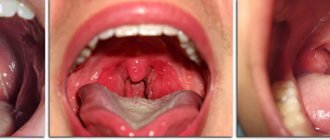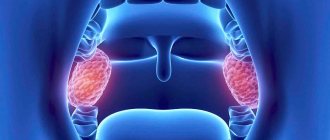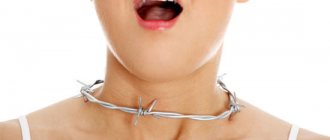Tonsillectomy for most patients with chronic decompensated tonsillitis is the method of choice and often the only treatment. In this regard, tonsillectomy is one of the most common planned operations in ENT surgical practice. This method of surgical treatment, according to various authors, reaches up to 40% of all surgical interventions on the ENT organs [1-3]. Indications for surgical intervention are frequent tonsillitis, as well as local complications of tonsillitis, such as peritonsillar abscess, retropharyngeal abscess, neck phlegmon, suppurating cervical lymphadenitis, febrile convulsions, severe tonsillogenic intoxication, diseases of distant organs and systems associated with pharyngeal pathology [4]. In the postoperative period after tonsillectomy, pain remains extremely relevant and in most cases the only symptom. The causes of pain immediately after tonsillectomy and in the next few days are the extensive open postoperative surface in the tonsillar niches, swelling and infiltration of the palatal arches [5]. The mechanism of post-traumatic pain is associated with an increase in the excitability of nociceptors resulting from the action of algogens - substances released from cells damaged as a result of surgical exposure (histamine, serotonin, ATP, leukotrienes, interleukin-1, tumor necrosis factor, endothelins, prostaglandins, nitric oxide, neurokinin , A, etc.) and formed in the blood plasma (bradykinin). Most often after surgery, patients are bothered by severe sore throat, which often radiates to the ears and also intensifies when swallowing [6]. In these cases, it is necessary to resort to painkillers, as well as follow a special diet that excludes coarse, salty, and spicy foods. Postoperative pain negatively affects the patient's eating and return to active daily life.
In addition, there is a danger of microbial contamination of the wound surface against the background of a decrease in local immunity and anti-infective resistance of inflamed tissues. In this regard, an important problem after tonsillectomy is to reduce the phenomena of reactive inflammation of tissues and reduce the pain syndrome that occurs in response to surgical trauma.
To achieve optimal analgesic effect after tonsillectomy, the use of a large number of different analgesic drugs is required.
According to the literature, over the years of tonsillectomy, multiple attempts have been made to improve pain relief in the postoperative period, both with systemic and local drugs. However, many of them have side effects and are poorly applicable in modern practice.
Opioid use has side effects such as nausea, vomiting, constipation, respiratory depression and severe sedation.
Nonsteroidal anti-inflammatory drugs (NSAIDs) increase the risks of bleeding and gastrointestinal disorders. According to experts, ibuprofen has some advantages in terms of tolerability over other non-steroidal anti-inflammatory drugs [7]. Cyclooxygenase-2 inhibitors (celecoxib) have similar analgesic properties to nonselective NSAIDs and have minimal side effects such as platelet dysfunction and gastrointestinal bleeding. However, one study showed that celecoxib does not provide sufficient analgesic effect after tonsillectomy and also often causes vomiting [8].
H. Tolska et al. [9] conducted a meta-analysis of 29 studies representing a double-blind, placebo-controlled, randomized trial of systemic analgesics used in the postoperative period after tonsillectomy. This study confirmed the beneficial analgesic effects of paracetamol, NSAIDs, dexamethasone, gabapentinoids and dextromethorphan after tonsillectomy on the day of surgery. Dexamethasone in multiple doses had an analgesic effect exceeding 24 hours. However, the use of steroids with high total doses and/or long-term use after surgery should be carried out with caution, taking into account the possible risks. Well-known side effects of systemic corticosteroid therapy (eg, moon face, Cushing's syndrome, diabetes mellitus) develop with long-term treatment. The risk of side effects from short-term, 1-2 weeks, systemic glucocorticosteroid therapy is minimal if treatment is not given to patients with diabetes, glaucoma, cataracts and osteoporosis. However, an increase in blood glucose levels and a rise in blood pressure can be observed during treatment with systemic glucocorticosteroids and in patients without diabetes mellitus or hypertension. A single dose of analgesics or the use of dexamethasone alone does not provide a clinically significant long-term analgesic effect after tonsillectomy.
A. Khan et al. found that gabapentin, pregabalin, and dextromethorphan may be useful in moderate doses as adjuvants to other analgesics. However, gabapentin and pregabalin are antiepileptic drugs, and dextromethorphan is an antitussive drug, and therefore their analgesic effect itself is not justified. Ketamine, an NMDA antagonist used as an anesthetic, can be used for pain relief after surgery. Its use in subanesthetic doses is effective in various types of surgeries to reduce opioid requirements and pain sensitivity. However, a patient receiving ketamine should be under constant medical supervision [10].
Thus, systemic analgesic drugs do not always have a good analgesic effect and in most cases have side effects. In this regard, in order to avoid the systemic effect of NSAIDs and at the same time ensure direct contact of the drug with the mucous membrane of the oral cavity and pharynx, it was necessary to develop local anesthetic drugs.
Topical drugs used in the complex treatment of pathological conditions of the oral cavity and pharynx can be divided into analgesics, anti-inflammatory drugs, antiseptics, drugs with a decongestant effect on the mucous membrane, etc. [11]. Local preparations in the form of lozenges, sprays, and rinses have also begun to be used in patients after tonsillectomy.
Many studies conducted in adult patients after tonsillectomy have shown the therapeutic effectiveness of benzydamine, especially when using a 0.15% mouthwash or spray - rapid relief of sore throat, reflex otalgia, and the absence of secondary bacterial complications were noted. However, in these studies there is mention of such an unpleasant sensation in some patients as a burning sensation in the throat associated with the ethyl alcohol contained in these drugs. This may indicate the irritating effect of these drugs, as well as the risk of bleeding from the tonsil niches [12, 13]. Topical therapy for the oropharynx may include rinsing, spraying, and lozenges. Rinsing with medicinal preparations is effective in treating the oral cavity and the base of the tongue. The use of a spray allows you to irrigate the back wall of the pharynx, however, the use of sprays is not recommended for children under 6 years of age and for patients with bronchial asthma. When assessing the effectiveness of medications in the form of resorption, it was noted that the concentration of active ingredients in the pharyngeal mucosa is higher than when using a spray and rinse. There is also a slower cleansing of the pharyngeal mucosa from drugs when using drugs in a resorption form, which ensures the maintenance of a high concentration of the drug at the site of inflammation [14].
In the search for non-pharmacological analgesia, various types of non-traditional approaches to pain management are being used. One such approach is transcranial electrical stimulation. It has been established that under the influence of this method the sensitivity of peripheral pain receptors decreases. This effect is caused by an increased concentration of β-endorphin circulating in the blood. However, this method has a number of contraindications and reduces the severity of pain for a limited period of time, and it is also economically unprofitable [15].
The use of a visual analogue scale (VAS) to assess pain allows us to assess the level of acute postoperative pain syndrome in patients who have undergone tonsillectomy [16].
In connection with the problem of pain relief for patients in the postoperative period after tonsillectomy, attempts have been made in recent years to produce new, safe, modern drugs. One of these drugs is Arnica Montana C9 (BOIRON) - a homeopathic monocomponent drug of plant origin.
The purpose of the study was to identify the effect of the homeopathic monocomponent herbal preparation Arnica Montana C9 (BOIRON) on the condition of patients who underwent tonsillectomy.
What is tonsillectomy?
Removal of palatine tonsils is one of the most common operations in the practice of an ENT doctor.
Many people think that it is performed only for children, but this is not so. Adults may also need it if chronic tonsillitis has become severe and is accompanied by purulent complications, and enlarged tonsils interfere with swallowing and even breathing, causing sleep apnea syndrome - a short-term cessation of breathing during sleep. The palatine tonsils sometimes become inflamed. Inflammation of the tonsils (tonsils) is referred to as tonsillitis. It, in turn, can be acute and chronic.
Inflammation of the tonsils. Photo: James Heilman, MD / (Creative Commons Attribution-Share Alike 3.0 Unported license)
Acute tonsillitis is called tonsillitis. With chronic tonsillitis, the inflammatory process lasts for years, with periodic exacerbations. An exacerbation is usually accompanied by fever, sore throat and sore throat, including when swallowing.
The tonsils become coated, bad breath appears, and the cervical lymph nodes become enlarged. If exacerbations recur one after another, and conservative treatment does not help, you have to resort to surgical treatment - removal of the tonsils (tonsillectomy).
Diagnostics
The need for tonsillectomy is determined by an ENT doctor after a conversation with the patient, a visual and instrumental examination, and obtaining the results of diagnostic studies. Laboratory tests and instrumental examinations not only indicate the presence of chronic tonsillitis, but also reflect the degree of influence of the inflammatory process on the body. Some of the tests and examinations are necessary to ensure that there are no contraindications to surgery.
Before removing tonsils, the following is prescribed:
- general blood test with leukocyte formula;
- blood chemistry;
- blood clotting test;
- blood for syphilis, HIV, hepatitis;
- rheumatic tests;
- general urine analysis;
- ECG;
- FLG;
- culture from tonsils.
Difference from tonsillotomy
Along with tonsillectomy, there is another operation with a similar name - tonsillotomy, in which enlarged tonsils are removed not entirely, but partially (usually in children). The indication for such an operation is the hypertrophy of these tonsils, when they occupy the entire space from the anterior palatine arch to the midline of the pharynx. With tonsillotomy, only the “excess” of enlarged tonsils is removed, returning them to normal size. Tonsillotomy is less traumatic than radical removal of the tonsils, and allows you to preserve their protective functions.
Advantages of the laser method
The laser method is one of the most modern methods of treating tonsils.
- Coagulation of the tonsils that occurs during laser exposure accelerates healing, thereby reducing the possibility of bleeding.
- The duration of the laser operation is up to 30-40 minutes.
- Laser treatment does not leave open wound surfaces.
- Laser tonsillectomy surgery is performed on an outpatient basis and does not require a long recovery period. The patient remains able to work after the operation.
- The operation is performed using local anesthesia
- To minimize trauma and facilitate the recovery period, laser tonsillectomy is usually performed in several stages.
Laser exposure is sterile in nature, it allows you to reduce the risks of negative consequences of the operation and minimize interference in the body using the partial excision method.
Why doesn't conservative treatment help?
Due to immunodeficiency (congenital or acquired) or concomitant diseases that contribute to prolonged inflammatory processes (diabetes mellitus, chronic infection), conservative treatment of tonsillitis may be ineffective.
Important! Group A beta-hemolytic streptococcus can settle in the tonsils, which causes rheumatic damage to the heart, joints and kidneys. Removing the tonsils avoids these complications.
Other factors that complicate conservative treatment include smoking and alcohol abuse. For teachers, singers and actors, the risk factor is the need to talk long, loudly and a lot.
At what age is surgery performed?
Surgical treatment may be recommended for adults and children over 8 years of age. By this time, the tonsils are fully formed. The palatine tonsils are an integral part of the pharyngeal ring - a group of tonsils (paired palatine and tubal, unpaired nasopharyngeal and lingual) - an important organ of local immunity of the nasopharynx and respiratory tract. Early removal of tonsils can contribute to the development of atopic diseases - allergic rhinitis or bronchial asthma. Such operations are usually not performed on children under three years of age, since they rarely have tonsillitis - the tonsils are too small.
Important! Tonsils can be removed no earlier than six months after polio vaccination.
How is the operation performed?
Three hours before the start of the operation, the patient is not recommended to drink or eat. The patient is placed in a surgical chair, and his pharynx is treated with anesthesia. After the anesthesia takes effect, the doctor directs a special device that uses a laser beam to target the tonsils. To avoid burns and damage to healthy tissue, radiation treatment is carried out in 4-5 approaches, each laser session lasts approximately 10-15 seconds. To prevent bleeding, laser coagulation (sealing) of blood vessels is performed. Tonsil removal is performed when the patient pauses breathing after taking a deep breath. To completely remove purulent deposits, large depressions are artificially expanded, then they are smoothed out, and the scars are excised with a laser. Such manipulations make it possible to create a discharge of the contents of the lacunae of the tonsils. When performing tonsillectomy, purulent deposits of the tonsils are completely eliminated. In some cases, within one to two hours after surgery, to eliminate the risk of complications, the patient is monitored and then sent home. Since laser tonsil removal is the most gentle method of treatment, the doctor can perform this manipulation in several stages.
Contraindications
They can be absolute (excluding the possibility of tonsillectomy) and relative, when everything is postponed until the reasons preventing the operation are eliminated.
Absolute contraindications:
- diseases with increased bleeding: hemophilia, hemorrhagic diathesis, Werlhof's disease, agranulocytosis, leukemia;
- heart failure grade 2–3;
- acute infectious diseases and exacerbation of chronic ones;
- active form of tuberculosis;
- cirrhosis of the liver.
Relative contraindications:
- caries (before sanitation - dental prophylaxis of the oral cavity);
- inflammation of the gums;
- pustular diseases of the mouth and skin;
- ARVI and influenza;
- exacerbation (decompensation) of chronic diseases;
- menstruation;
- pregnancy after the 26th week due to the risk of premature birth.
Types of tonsil removal surgeries
Classical
The surgeon installs a mouth retractor and separates the tonsil tissue along with the capsule from the surrounding tissues in a “blunt” way using a raspator. The bleeding is stopped, the vessels are cauterized with an electrocoagulator or laser. The whole process takes from 15 to 40 minutes.
Electrocoagulation
Figure 1. Incision at the base of the tonsil during electrocoagulation.
Source: Maxillofacial Plastic and Reconstructive Surgery / Open-i (Attribution 4.0 International) Instead of a scalpel, a high-frequency current electrode is used. The vessels are “sealed”, so blood loss is minimal. Recovery may take longer due to associated injuries to surrounding tissues.
Removed tonsils. Maxillofacial Plastic and Reconstructive Surgery / Open-i (Attribution 4.0 International)
Cryodestruction
Tonsils are frozen with liquid nitrogen. As a result, they become pale, flat and hard, and after a day they die and are gradually rejected. The method is recommended for patients with an increased risk of bleeding (thrombocytopenic purpura, hemophilia, etc.), severe heart failure and endocrine pathology.
Important! The cryosurgical method is used in a series of procedures lasting up to 1.5 months. During this time, a relapse of the disease is possible if not all of the tonsil tissue has been destroyed. Cryosurgery is used when classical surgery is not possible.
Ultrasonic destruction
High-frequency sound vibrations warm up the tissues to prevent bleeding. Unlike exposure to liquid nitrogen or electricity, surrounding tissue is almost not damaged. Ultrasound method is one of the least traumatic.
Radio wave destruction
A probe is installed inside the tonsils, which generates radio waves. They evaporate the water from here and cause scarring. Ablation can be repeated several times. Anesthesia is not needed here - only local anesthesia or light sedation. Recovery is quick, but radical tonsil removal is almost impossible. Therefore, radio wave therapy is used for their hypertrophy, but not for chronic tonsillitis, when radical intervention is required.
Cold plasma destruction
A relatively new method of removing tonsils. It is based on the property of cold plasma (radio frequency energy converted into ionic dissociation) to separate molecular bonds in tissues without releasing thermal energy. Plasma is called cold because it causes minimal heating of the tissue, which means that pain after surgery will be insignificant, recovery will be easy and quick. The method is low-traumatic and can be used for partial or complete removal of tonsils.
Laser removal
Laser tonsillectomy can be complete or partial (with cutting of the upper layers of the tonsils). Different types of laser are used - carbon, infrared, etc. Only pathological tissues are removed, and healthy ones are not affected. Other advantages include immediate separation of the tonsil from the underlying tissues with coagulation of blood vessels, which reduces the risk of bleeding and infection.
Surgical treatment of hypertrophy of tonsils and adenoids
In the Republic of Belarus, the concept of informed voluntary consent to medical intervention is reflected in Articles 27, 28, 29 and 30 of the Law on Health Care, which lists the general rights of the patient, in particular: the right to choose a doctor, informed voluntary consent, refusal of medical intervention, the right to information about your health and all aspects of medical interventions proposed or carried out.
From the point of view of medical law, informed consent to medical intervention should be understood as the patient’s voluntary, competent acceptance of the proposed treatment option. This decision should be based on receiving complete, objective and comprehensive information about the upcoming treatment, its possible complications and alternative treatment methods.
In accordance with the above provisions, we invite you to familiarize yourself with the principles and methods of surgical treatment of hypertrophy of the tonsils and adenoids. The written information provided to you serves this purpose. Read it carefully to discuss any unclear points with your doctor.
General concepts about tonsillitis, tonsil hypertrophy and adenoids.
Every healthy child has lymphoid tissue in the pharynx, which is united into the so-called lymphadenoid pharyngeal ring. It includes the palatine tonsils - “tonsils” - they can be seen when examining the mouth - they look like balls protruding on the sides of the tongue, the pharyngeal tonsil - it cannot be seen during a direct examination of the oral cavity, it hides in the nasopharynx, behind the palate, lingual tonsil - located at the root of the tongue, and many lymphoid follicles scattered along the back wall of the pharynx, at the entrance to the larynx. These formations help the child defeat pathogenic bacteria that enter the throat during breathing and eating, and contribute to the formation of local immunity - protection against pathogens. By the way, in these organs there are no cells that affect the sexual development of the child, they do not produce sex hormones, therefore their diseases do not affect the sexual development of the child, and if they are removed if necessary (more on this later), sexual development is not disrupted.
Location of adenoid vegetations in the nasopharynx (adenoid vegetations are highlighted in red)
In early childhood - usually from 2 to 5-7 years - the described organs work very hard, as the child expands the scope of contacts with peers by attending kindergarten, and inevitably often becomes infected and develops respiratory diseases. Moreover, if the child’s immune forces are not strong enough due to congenital characteristics, environmental factors and other reasons, the lymphoid organs increase in volume. This enlargement of the palatine tonsils is called “hypertrophy of the palatine tonsils”; they can become inflamed - inflammation of the tonsils is called tonsillitis. An enlarged, chronically inflamed pharyngeal tonsil is called “adenoids.”
Adenoids have a significant impact on health and the development of nearby organs. What kind of influence is this? A chronic inflammatory process, constantly smoldering in the adenoid tissue, periodically exacerbating, contributes to protracted, recurrent diseases of the trachea and bronchi (bronchitis, obstructive bronchitis, tracheitis, pharyngitis), can independently cause or aggravate the course of allergies, in severe cases manifested in the form of bronchial asthma, allergic rhinopathy, atopic dermatitis.
Adenoids, filling the nasopharynx, cause difficulty in nasal breathing, impair the functioning of the auditory tubes, which cannot sufficiently deliver air to the middle ear, as a result of which secretory otitis media develops, which can lead to hearing loss, and if an infection enters the ear, to acute hearing loss. inflammation – acute purulent otitis media. A noticeable obstacle to the passage of an air stream through the nose leads to breathing through the mouth, and, consequently, to the fact that the nose cannot perform its functions, which, in turn, are very important. The consequence is obvious - untreated air enters the respiratory tract - not purified, not warmed and not humidified. And this greatly increases the likelihood of inflammatory processes in the pharynx, larynx, trachea, bronchi, and lungs (tonsillitis, laryngitis, tracheitis, bronchitis, pneumonia).
Poor breathing through the nose contributes to improper development of the maxillofacial area - the bite of the teeth is disrupted, the shape of the face changes (the so-called “adenoid face”), the paranasal sinuses develop poorly, which in primary school age leads to sinusitis - sinusitis (sinusitis, sinusitis). , ethmoiditis), and later – to chronic sinusitis, the growth of polyps in the sinuses and nasal cavity.
What factors contribute to the appearance of adenoids?
- Heredity - at least if the parents suffered from adenoids, the child, to one degree or another, will also encounter this problem.
- Inflammatory diseases of the nose, throat, pharynx - and respiratory viral infections, and measles, and whooping cough, and scarlet fever, and tonsillitis, etc.
- Eating disorders - especially overfeeding.
- Tendency to allergic reactions, congenital and acquired immunity deficiency.
- Violations of the optimal properties of the air that the child breathes - very warm, very dry, a lot of dust, an admixture of harmful substances (ecological conditions, excess household chemicals).
Thus, the actions of parents aimed at preventing adenoids come down to correction, and even better, to the initial organization of a lifestyle that promotes the normal functioning of the immune system - feeding according to appetite, physical activity, hardening, limiting contact with dust and household chemicals.
If the child, along with the adenoids, has enlarged tonsils
At the age of 8-9 years, when a child has enlargement (hypertrophy) of the palatine tonsils, but has not yet developed chronic tonsillitis (the child does not suffer from sore throats, purulent plugs do not accumulate in the lacunae), it is possible to reduce them using minimal surgical intervention on the tonsils volume and stop the pathological process. In this case, otolaryngologists suggest that when removing the adenoids, the palatine tonsils are also reduced in volume (“cut”) - this operation is called tonsillotomy. If this is not done, the child has a high probability of even greater enlargement of the palatine tonsils (so-called compensatory hypertrophy), which will negate the results of adenotomy - again the child will begin to breathe poorly through the nose, get sick often, snoring will not go away or will get worse. In addition, against the background of hypertrophy, a chronic inflammatory process often develops in the palatine tonsils, which subsequently requires their complete removal.
Tonsillitis can be acute or chronic. Acute tonsillitis - tonsillitis - is an infectious disease that requires conservative (drug) treatment at home or in an infectious diseases hospital under the supervision of a pediatrician. The causative agents of infectious diseases of the respiratory tract (most often streptococci) after a sore throat remain in the palatine tonsils, and their chronic inflammation develops - chronic tonsillitis. Under unfavorable circumstances (hypothermia, stress, viral infection), the process in the tonsils is activated. This occurs in the form of another sore throat with plaque on the tonsils or purulent plugs. What is very dangerous is that each exacerbation of tonsillitis can cause complications in the form of diseases of other organs and systems of the child’s body, most often rheumatic diseases of the heart and joints, kidney diseases (pyelitis, pyelonephritis, glomerulonephritis). In addition, exacerbation of tonsillitis or tonsillitis sometimes causes complications in the form of an abscess (ulcer) in the pharynx. This complication is called peritonsillar abscess.
In chronic tonsillitis, the course of the disease can go so far that the tonsils cease to perform their protective function; this form of tonsillitis is called “decompensated” and cannot be cured with medications; it requires surgical treatment - removal of the tonsils. The operation to remove the tonsils is called a tonsillectomy.
When should you consult an ENT doctor so that it is not too late?
If your child begins to get a “runny nose” frequently and it lasts longer than 10-12 days, the child, even in a state of relative health, begins to breathe worse through his nose, snores during sleep, and begins to be unable to hear (the child becomes inattentive, asks questions again, asks to increase the volume when watching TV programs ), you should visit an otolaryngologist to assess the condition of the pharynx, determine the presence of adenoids and the degree of their enlargement.
How does a doctor determine whether a child has adenoids and what size they are?
This is done using a small round mirror inserted behind the soft palate (this is difficult to do in young children), or by digital examination of the nasopharynx: the doctor feels the nasopharynx with his finger for 1-2 seconds. This is the most reliable, reliable and safe method for diagnosing adenoids. An X-ray examination is also used - a lateral radiograph of the nasopharynx using a contrast agent that is instilled into the nose, an endoscopic examination - examination of the posterior parts of the nose and nasopharynx with rigid or flexible endoscopes after anesthesia of the mucous membrane - a painful procedure for young children and therefore used in cases that are difficult to diagnose cases (for example, with congenital underdevelopment of the nasal passages, suspected tumor, etc.).
The size of the adenoids is assessed in degrees - there are three of them: the first - when the adenoids occupy a third of the volume of the nasopharynx, the second - two-thirds, and the third - when the adenoids fill the entire nasopharynx.
The grade is determined to evaluate changes in the adenoids during treatment, and not to decide whether to remove them or not. Indications for adenoid removal are determined by other criteria. More on this later.
Is it possible and necessary to “treat adenoids”?
We emphasize that it is not only possible, but also necessary to treat, but not the adenoids, but the chronic inflammatory process in them, called adenoiditis. Until the child develops the changes mentioned earlier, both local treatment should be used in the form of drops, irrigation of the nasal mucosa and nasopharynx with aqueous solutions that have anti-inflammatory, antiallergic and antimicrobial properties, as well as general treatment methods, including vitamin preparations, agents, those affecting the immune system, locally acting vaccine preparations, physiotherapeutic methods (magnetic and laser therapy, inhalation methods of drug administration have proven themselves well). Homeopathic methods of treatment are not contraindicated. However, when, during observation of a child, changes appear in the ears (recurrent otitis, dysfunction of the auditory tubes, exudative otitis), paranasal sinuses (recurrent sinusitis, chronic sinusitis), there are chronic or recurrent bronchopulmonary diseases, allergies, adenoids, regardless of the degree of their increase are subject to mandatory removal.
How urgently should the operation be performed?
Operations to remove adenoids and tonsils - adenotomy, tonsillotomy, tonsillectomy - are planned, that is, they are performed when the child is in full health or in remission of chronic diseases. It cannot be performed during acute illnesses (ARI) and 3-4 weeks after recovery. Thus, it is always possible to perform this operation in a period favorable for the child, which will minimize the risk of postoperative complications.
Is it possible to delay or not do the operation at all, because, they say, the adenoids are resolving, maybe they will “outgrow”?
Indeed, adenoid tissue atrophies over time, however, this process begins in adolescence and ends at 18-20 years of age. This process is long, and by the time it is completed, as a rule, a number of irreversible diseases requiring surgical treatment have formed (chronic otitis media, sinusitis, tonsillitis). Thus, it is obvious that it is more expedient to perform a minor operation in early childhood and improve the child’s health than to condemn him to long-term treatment, which often does not lead to full health, at an older age.
Do adenoids grow back, are relapses common?
Yes, adenoids can recur.
We draw attention to the fact that, regardless of the qualifications of the surgeon, it is impossible to completely remove the pharyngeal tonsil - at least something will remain. And there is always a possibility that adenoids will appear (grow) again. This happens quite rarely - in 4-5% of cases. However, relapse does not mean repeated surgical treatment. As a rule, adenoid tissue can reappear in the nasopharynx no earlier than after 7-12 months, during which time the function of the auditory tubes and nose usually has time to recover, the volume of the nasopharynx increases as the child grows, and the newly enlarged adenoids no longer have such a detrimental effect, as before the operation. Typically, conservative treatment methods can solve the problem. Repeated adenoid removal is required in 1-2 patients out of a thousand operated on.
The reappearance of adenoids is a reason for serious parental consideration. And it’s not at all about the fact that a bad doctor was “caught”. And the fact that all doctors taken together will not help if the child is surrounded by dust, dry and warm air, if the child is fed with persuasion, if TV is more important than walks, if there is no physical activity, if... If it is easier for mom and dad to take the child to otolaryngologist, than to part with your favorite carpet, organize hardening, sports, sufficient time in the fresh air.
Removed tonsils cannot grow back. Tonsillectomy allows you to radically and permanently solve the tonsillar problem.
How are adenoids removed?
This operation is performed in children under 8 years of age without local anesthesia; for children over 8 years of age, anesthesia is used by lubricating or irrigating the nasopharyngeal mucosa with a lidocaine solution. In young children this is prohibited due to the possibility of asphyxia (suffocation) developing in the child. This operation is unpleasant, but not painful; the sensations experienced by the child are comparable to lubricating the throat. It lasts a short time (5-6 seconds) and, with proper psychological preparation of the child, is tolerated satisfactorily. Under special circumstances - the presence of concomitant diseases in which local anesthesia is undesirable, the child’s pronounced negativism towards medical manipulations, emotional lability and psychological unpreparedness of the child and parents for surgery without anesthesia - adenotomy and tonsillotomy are performed under general anesthesia, which involves a more in-depth examination of the child.
The simplicity of the operation does not indicate the safety of the operation. Complications due to anesthesia, bleeding, and damage to the palate are also possible. But all this does not happen often. You can find a list of possible complications below.
Surgeons have long abandoned the removal of adenoids using ultrasound and laser due to the huge risk of complications.
How long does a child stay in the hospital after adenotomy and tonsillotomy?
Due to the high risk of bleeding in the postoperative period, we recommend staying in the hospital for 24 hours after surgery to remove adenoids. Usually the child is discharged home the next day. After tonsillotomy, the child is observed in the hospital for a day longer.
What should you do after your baby is discharged?
The child is discharged from the hospital under the supervision of an ENT doctor or pediatrician at the clinic at the place of residence. Home treatment is usually recommended for 3-5 days.
In this case, physical activity should be limited, however, there is no need to keep the child in bed. When eating during the first days, you should not eat hot, spicy foods, sour juices and fruits, carbonated drinks, or ice cream. After 3-5 days, the diet becomes normal. 3-5 days after discharge, if the child’s general condition is satisfactory, there is no elevated body temperature, and the wound in the pharynx is healing smoothly, you can visit the children’s group and go outside. You can’t just do sports or go to the pool. The wound in the nasopharynx heals completely in 2-3 weeks. A month after the operation, there are no restrictions in lifestyle or diet.
How to remove adenoids at the Children's City ENT Center?
To establish a diagnosis, if there is no ENT doctor in the clinic, you can make an appointment at the city ENT consultation office by calling 2-78-49-00 (inquiry). Consultative reception is carried out on weekdays, from 8.00. until 20.00.
If the diagnosis of “hypertrophy of the palatine tonsils, adenoids” has been established and the decision to operate on the child has been made, with a referral for surgical treatment issued at the clinic, you should go to the emergency department of the 3rd Children's Clinical Hospital at any time convenient for you. Your child will be registered for hospitalization on the day you choose and will be given an examination plan (a list of tests necessary to perform the operation). Hospitalization is carried out on Tuesday and Thursday, from 13.00. until 15.00. and on Sunday from 16.00. until 18.00. During hospitalization, the child is examined by an ENT doctor, who evaluates the examination performed in the clinic in accordance with the scope of surgical treatment and the method of anesthesia and, in the absence of contraindications to the operation, admits the child to the hospital. The operation is carried out the next day. Mothers with children under 5 years of age are hospitalized and issued a certificate of incapacity for work.
Postoperative period
Figure 2. Appearance of the throat after tonsillectomy. Source: James Heilman MD, CC BY-SA 3.0.
Recovery usually takes 3–4 weeks, the first of which takes place in the hospital. This is necessary in order to respond in time to the most common complication of tonsillectomy – pharyngeal bleeding. To prevent it, hemostatic drugs are prescribed.
From the operating room the patient is transferred to a ward under the supervision of the attending physician. On the first day, it is forbidden to swallow, spit or expectorate saliva. You can only breathe through your mouth. In case of severe pain, the patient is prescribed painkillers.
A diet is recommended for all days of the postoperative period
- on the first day, adults should refrain from eating, and small children should not eat or drink for the next 6 hours;
- In the first week after surgery, it is recommended to eat liquid, smooth food;
- During the recovery period, food should be soft; it is not recommended to eat too hot, cold, sour, or spicy. This may irritate the mucous membranes of the throat and mouth.
- In the postoperative period, if necessary, a course of antibiotics is prescribed.
Figure 3. Memo: what you can and cannot eat after surgery.
Source: verywellhealth.com Bed rest must be observed for 2 days. In most cases, the patient is discharged from the hospital within a week for outpatient observation and treatment.
Candidiasis of the tonsils
The appearance of plaque on the tonsils should puzzle any person. It is evidence of various diseases. Plaque on the tonsils is often accompanied by pain, fever and redness of the throat, or these symptoms may be absent, which indicates candidiasis of the tonsils.
The appearance of plaque on the tonsils, what is it connected with
- If plaque appears on the tonsils, but there is no temperature, this may indicate the presence of oral candidiasis.
- If the plaque is not accompanied by a fever, or it is low-grade, then there is a high probability that the cause is a yeast fungus of the genus Candida.
- Oral candidiasis is characterized by plaque not only on the tonsils, but also on the entire surface of the tongue. This is especially noticeable in the morning, after sleep.
- If the cause of the plaque is candidiasis, then at first there is a thin whitish film and small curdled lumps on the tongue, to which a person may not pay attention. Gradually the amount of plaque increases, and the problem becomes noticeable. In this case, you need to visit a doctor and take an oral swab to check for fungus.
Candidiasis of the tonsils and pharynx
In some patients, the development of candidal lesions on the pharynx and tonsils can be observed. This happens when:
- Mycotic sore throat.
- Fungal sore throat.
- Yeast sore throat.
If a mycotic type process is involved, then the tonsils increase in size, redness of the pharynx occurs, and white cheesy plaques and follicular plugs appear on the mucous membrane, in which microscopic and cultural examination will reveal yeast fungi of the genus Candida.
Fungal tonsillitis, unlike vulgar tonsillitis, occurs with mildly painful symptoms. There is also no local reaction, and the temperature may be within normal limits. If the disease is not detected and not treated, it continues for months with periodic exacerbations. Wherein:
- Exacerbation may occur after antimicrobial antibiotics.
- There is a gradual formation of allergic changes in the body (allergy to medications, especially antimicrobial antibiotics).
Cheilitis often depends on Candida fungi
Cheilitis (damage to the red border of the lips). This disease is often caused by Candida fungi. Candida cheilitis occurs in both children and adults. This disease differs in the duration of treatment and is combined with other forms of mycosis, such as candidiasis. Candidal cheilitis must be differentiated from cheilitis of a different etiology (bacterial), or more precisely:
- Streptococcal.
- Actinic, which is caused by solar radiation.
- Hypovitaminosis, caused by a lack of riboflavin.
A combination of several factors is possible, which include degenerative changes, radiation exposure, including candidiasis infection.
Doctors associate the increase in the number of cases of candidiasis of the mucous membrane of the throat and tonsils in the adult population, first of all, with the spread of oral sex among women and men. The second reason is the negative and unqualified consequence of treatment of ENT organs.
Causes of candidiasis on the tonsils
- Irrational and long-term treatment of chronic diseases with antibiotics (for example, treatment of tonsillitis).
- The initial stage of the disease is painless. Therefore, it often becomes chronic.
- It is not always possible to determine even by laboratory methods. Indeed, with any respiratory diseases, the tonsils enlarge and turn red. Antibiotics taken often distort the picture of test results and thrush (candidiasis) goes unnoticed. It is necessary to pay attention to the following symptoms: low-grade fever (37º C);
- dull pain when swallowing;
- burning and soreness;
- sensation of a foreign body in the throat;
- feeling of discomfort when eating.
Candidiasis of the tonsils in children
Very often thrush is confused with aphthous stomatitis
Candidiasis in a child on the tonsils is diagnosed when a white or gray coating forms on the mucous membrane of the tonsils. If the disease has been advanced, the doctor may detect ulcers on the surface of the mucous membrane in the child.
Thrush can be easily confused with aphthous stomatitis, which is caused by the herpes virus.
Therefore, first, the child is given a differential diagnosis, excluding other diseases. After this, based on the culture results, they will find out which fungus caused the disease, because some drugs are effective only against Candida, while others are effective for other infections.
Treatment of tonsil candidiasis
- Treatment of tonsils (if the form is not chronic) begins with local therapy with antifungal drugs (Pyoctanan solution 1%; Gentian violet solution, Levorin solution or Quinozol aqueous solution).
- A greater therapeutic effect can be achieved if the above drugs are used as inhalations rather than rinses.
Whatever treatment of the disease in question is proposed in this article, these are only recommendations and information.
Only a doctor, based on a comprehensive study and taking into account concomitant diseases, can make a diagnosis and prescribe a qualified cure for this disease.
Source: //kandidoz.org/kandidoz-mindalin.html
Complications after removal of tonsils
The most common of them is bleeding, which can develop both on the first day after the intervention (primary bleeding, and 5-6 days after it. The incidence of postoperative pharyngeal bleeding ranges, according to various observations, from up to almost 60%. Minor bleeding after removal of the tonsils is stopped using a tampon, electrocoagulation, or the anterior and posterior palatine arches are sutured together to reduce the area of bleeding.
Also, as a side effect of the procedure, there is a risk of blood aspiration (blood entering the respiratory tract). Then the blood is urgently removed with an electric suction and bronchoscopy is performed.
After removal of the tonsils, swelling of the soft palate and larynx is possible. If signs of difficulty breathing appear, decongestant therapy is carried out.
If the wound becomes inflamed after removal of the tonsils, antibiotic therapy is prescribed.
In most cases, the operation takes place without complications or side effects. If the patient experiences pain, the doctor will prescribe analgesics on the first day after removal of the tonsils, and then non-steroidal anti-inflammatory drugs.
Sometimes the patient may experience voice changes, taste disturbances, and nasal sounds.
It is extremely rare to experience damage to the temporomandibular joint due to forceful opening of the mouth with a mouth opener during tonsil removal.
Preparing for removal
Carrying out a tonsillectomy requires certain preparation. The patient must undergo a preoperative examination, which includes:
- conducting a number of laboratory tests (general blood test, urine test, coagulogram, test for HIV and infections, etc.);
- fluorography;
- ECG;
- taking a smear from the mucous membrane of the tonsils and the back wall of the pharynx;
- sanitation of the oral cavity;
- examination by a therapist and, if necessary, doctors of narrow specializations (rheumatologist, endocrinologist, gynecologist, etc.).
If the patient is taking medications that inhibit blood clotting (anticoagulants), they should be stopped a few days before the tonsillectomy. To relieve anxiety before having your tonsils removed, you can start taking sedatives.
On the appointed day, four to six hours before the intervention, it is necessary to finish eating so as not to provoke a gag reflex, and the anesthesia will work better.
Sources
1. Palchun V.T.
Otorhinolaryngology: national guidelines. M.: GEOTAR-Media, 2016. 2. Karpishchenko S.A., Svistushkin S.M. Chronic tonsillitis and tonsillitis. Immunological and clinical aspects. St. Petersburg: Dialogue, 2017.
3. Lukan N.V., Sambulov V.I., Filatova E.V. Conservative treatment of various forms of chronic tonsillitis. Almanac of Clinical Medicine, 2010, 23: 37-41.
4. Belov, B.S., Shcherbakova M.Yu. A-streptococcal tonsillitis: modern aspects. Pediatrics. 2009, 88(5): 127-135.
5. Turovsky A.B, Kolbanova I.G. Chronic tonsillitis - modern concepts. Doctor.RU, 2009, 49(5): 16-21.









